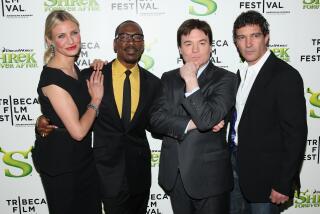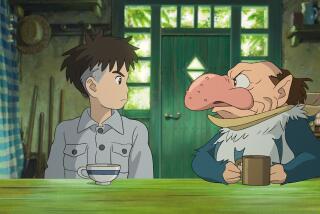A Sophisticated . . . Ogre?
A gleeful piece of wisenheimer computer animation, “Shrek” doesn’t have much patience for traditional once-upon-a-time fairy tales: The only time one appears, its pages end up as reading material and then some in the hero’s outhouse.
That hero is a fierce ogre with a name that’s Yiddish for fear. He made his debut in William Steig’s 1990 children’s book, about a cheerfully ugly monster who’s “tickled to be so repulsive,” that has become something of a classic.
As the more wised-up version of that wised-up modern fairy tale, “Shrek,” the film, is all comic attitude, all the time. Casual, carefree, consistently amusing, it plays a lot like the earlier “Aladdin,” which Ted Elliott & Terry Rossio, lead writers and co-producers here, also wrote.
Like “Aladdin,” which did wonderful things with Robin Williams as the irrepressible genie, “Shrek” is blessed with Eddie Murphy as a motor-mouth donkey named, well, Donkey. Though his sidekick work in “Mulan” seemed forced, Murphy (taking off from a script by Elliott & Rossio and Joe Stillman and Roger S.H. Schulman) is spectacular here, and he’s in good company.
Mike Myers, using a Scottish accent that echoes one of his Austin Powers characters, brings not only sharp comic timing but also a kind of sensitivity to the role of Shrek, an ogre who’s more troubled by the world’s disdain than he was in the book. And Cameron Diaz is appropriately feisty as Fiona, a princess with a secret and a woman who hasn’t let being trapped in a tower affect her attitude or her style.
Though Steig’s book did without a classic villain, “Shrek” adds a dandy one in Lord Farquaad, a tiny Richard III type (wonderfully voiced by the tall John Lithgow) whose enormous head is packed with evil thoughts, like how best to give the third degree to a gingerbread man who’s reluctant to talk.
Farquaad is the ruler of a super-sanitized place called Duloc, which he’s determined to turn into the most perfect kingdom on earth. (Any resemblance between Duloc and a certain amusement park run by “Shrek” producer Jeffrey Katzenberg’s former employer is probably not coincidental.)
As part of this quest for perfection, Farquaad places a bounty on fairy-tale characters like Pinocchio and the Three Bears and forcibly exiles them. Donkey is one of them, and when he’s saved by Shrek, whom he admires as “a mean, green fighting machine,” he decides the two of them should be buddies. “Freaks got to stay together,” he declares, adding, with perfect animated logic, “every monster needs a sidekick.”
Shrek doesn’t quite see it that way. He’s a privacy-loving Garbo type who just wants to be left alone, which is why he keeps his property posted with “Beware of the Ogre” signs. So when all those dispossessed fairy-tale types invade his swamp, Shrek stamps off to Farquaad’s castle to complain.
That miniature man is having crises of his own. His magic mirror informs him that to have the perfect kingdom, he must marry a princess. In one of “Shrek’s” many pop culture references, the mirror parodies “The Dating Game” by presenting him with a choice of three bachelorette princesses, including one, Snow White, who comes with the advisory “though she lives with seven other men, she’s not easy.”
Farquaad settles on Fiona, and when Shrek presents his case, he tells the ogre that he can have his swamp back if he rescues the princess from her dragon-guarded castle. So off Shrek sets on what turns out to be a most unconventional quest with the determined Donkey, “a dumb, irritating, miniature beast of burden” tagging along. “Yes, he talks,” Shrek says of his annoying companion. “It’s getting him to shut up that’s the trick.”
“Shrek’s” pair of first-time directors, Andrew Adamson and Vicky Jenson, keep the pace brisk enough to balance flatulence jokes with an earnest theme about being comfortable with who you are. The team also makes good use of advances in computer technology that allows human creatures to look more like flesh and blood. The film also shrewdly utilizes pop classics like “Try a Little Tenderness,” “You Belong to Me” and “On the Road Again” to simultaneously underline emotion and appeal to the parents of the film’s intended audience.
Some of “Shrek’s” best moments, however, are when it goes off message and simply fills the screen with sharp riffs on the fairy-tale characters it keeps running across. There’s fun to be had with three blind mice as well as three little hip-hop pigs, and a classic run-in with Robin Hood and his chorus line of merry men that includes a great visual reference to “Crouching Tiger, Hidden Dragon.” Smartly constructed to appeal to children and their parents, this fractured fairy tale not only knows there’s no substitute for clever writing, it also has the confidence to take that information straight to the bank.
*
* MPAA rating: PG, for mild language and some crude humor. Times guidelines: the usual flatulence jokes and some slightly risque humor.
(BEGIN TEXT OF INFOBOX / INFOGRAPHIC)
‘Shrek’
Mike Myers: Shrek
Eddie Murphy: Donkey
Cameron Diaz: Princess Fiona
John Lithgow: Lord Farquaad
*
A PDI/DreamWorks production, released by DreamWorks Pictures. Directors Andrew Adamson, Vicky Jenson. Producers Arib Warner, John H. Williams, Jeffrey Katzenberg. Executive producers Penney Finkelman Cox, Sandra Rabins. Screenplay Ted Elliott & Terry Rossio and Joe Stillman and Roger S.H. Schulman, based on the book by William Steig. Editor Sim Evan-Jones. Music Hary Gregson-Williams, John Powell. Production design James Hegedus. Running time: 1 hour, 29 minutes.
In general release.
More to Read
Only good movies
Get the Indie Focus newsletter, Mark Olsen's weekly guide to the world of cinema.
You may occasionally receive promotional content from the Los Angeles Times.











